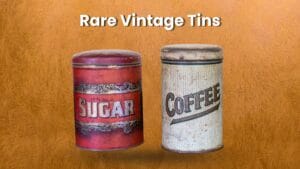I’m sure you must’ve found yourself holding an old Altoids tin and wondering if it’s worth something at least once! And you’re not alone for that. These little metal boxes have quietly become some of the most sought-after collectibles today, with pieces selling for up to $400!
But not all Altoids tins are created equal. Some are worth just a few bucks. The trick to knowing whether your old Altoids tin is worth anything is knowing what to look for. Let me walk you through everything you need to know about old Altoids gems!
The Journey of Altoids Tins
It all started back in 1780, when a guy named Smith Kendon decided to help people with upset stomachs. So he created these super-strong lozenges in London to ease intestinal discomfort. That’s right – Altoids weren’t meant to freshen breath. They were medicine.
Smith’s company did pretty well, but in the mid-1800s, Callard & Bowser overruled them and turned Altoids into something much bigger. But that wasn’t it. The ownership then went into many other hands, like United Biscuits, Wrigley, and eventually, Mars Inc.
Another interesting fact is that Altoids didn’t hit America until 1918. And when they first arrived? They came in cardboard boxes. The iconic metal tins didn’t show up until the 1920s. Later, they switched to metal boxes to protect the brittle mints!
How to Identify Authentic Vintage Altoids Tins?
Spotting real vintage Altoids tins isn’t a big deal if you know what signs to look for. From its material to its design, logo, and shape, here’s a breakdown of the key identification features of original Altoids tins.
Materials
Real vintage Altoids tins feel light but sturdy in your hand as they’re made from tin-plated steel – basically, thin steel sheets coated with tin to prevent rust. If you’ve got a magnet handy, authentic tins will stick to it every time.
Besides, older tins also display some specific features:
- Patina: Most vintage Altoids tins develop patina naturally over decades. You’ll see dulling of the original shine, slight discoloration, or even minor rust where the tin plating has worn through. If an “old” tin looks uniformly shiny, be suspicious.
- Weight: Older tin-plated steel has a subtle heft that feels different from modern aluminum or cheaper alloys.
- Sound: Tap an authentic vintage tin and you’ll hear a distinct, slightly resonant metallic sound that comes from the material. Aluminum or alloy versions may create muted sound.
Size & Shape
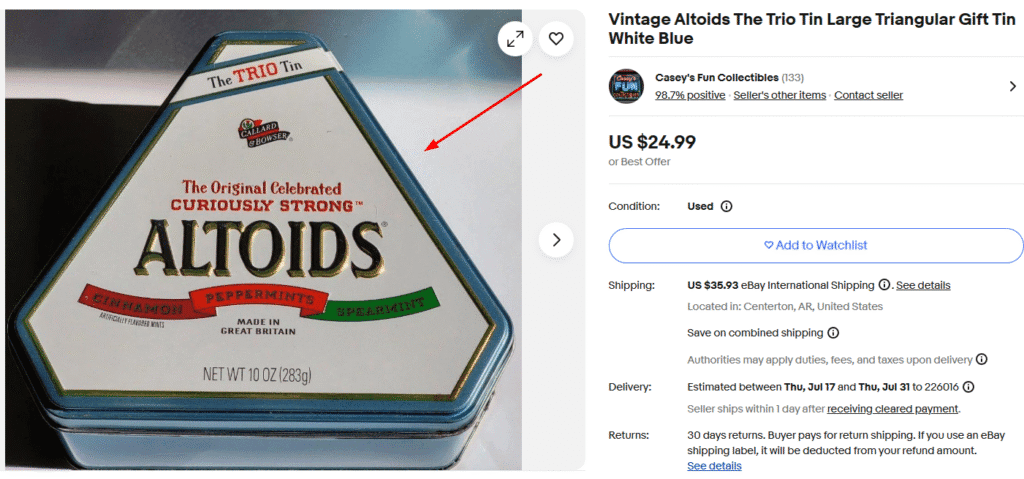
While most Altoids have stuck with that iconic rectangular slide-top design, there are some details and variations to watch for.
- Standard Dimensions: Generally, the dimensions of Altoids tins are pretty consistent – about 3.75 inches long, 2.25 inches wide, and 0.75 inches deep for regular mints. Big deviations from this should make you suspicious unless it’s clearly marked as special.
- Special Editions: Apart from regular tins, there are also larger tins for bulk candy or tiny “curiously small” versions for promotions. These are rarer but legitimate.
- Lid Styles: The lid style of Altoids tins also changed over time. Earlier tins had flat tops with painted graphics. Later ones switched to embossed lids with raised text and imagery. When this happened, they also stopped painting the bottoms.
Design Elements
The visual aesthetics of an Altoids tin also prove to be true indicators for dating and authentication. Here’s how:
Color Schemes
Most vintage Altoids mint tins stick to the classic red, white, and black palette, though different flavors brought their own colors. For example:
- Peppermint: That classic deep red with white and gold text
- Wintergreen: Green backgrounds
- Cinnamon: Golden yellow with dark lettering
- Spearmint: Light green or blue-green
Besides, real vintage tins often have that bolder color saturation you get from older lithography.
Exterior Graphics & Print Type
Altoids changed its exterior graphics over time. For instance, early tins were simpler and more illustrative. Pay attention to how the “Curiously Strong” slogan is placed, what font it uses, and how it fits into the overall design.
The style can range from Victorian-influenced to Art Deco to mid-century modern. Besides, the tins may also feature unique motifs relevant to the flavor of the mints.
Also, vintage tins used lithography printing, which you can identify by the textured feel and, upon close inspection, visible small dots (half-tone dots).
Interior Graphics
Many vintage tins have printing inside the lid or on the bottom – mostly addresses, advertising messages, company information, and even manufacturing codes. This interior printing is often better preserved than the outside and can be your best clue for dating.
Also, what’s inside a tin matters, too. Flip open a vintage tin and you should see a crinkled paper wrapper. This isn’t just packaging – it’s part of the experience. Authentic vintage tins include historical information, ingredient lists in period fonts, and sometimes even “established 1780 in the reign of George III.”
This paper is more than just marketing stuff. It prevents the mints from rattling around and provides space for Altoids to do the storytelling.
Font and Typography
For example, early tins (1920s-1960s) used traditional serif fonts that often looked hand-lettered. Mid-period tins (1960s-1990s) switched to cleaner sans-serif fonts. Modern ones? Computer-perfect spacing that lacks character.
Also, look closely at how “Altoids” and “Curiously Strong” are positioned. The spacing and style evolved with printing technology.
Logos & Branding Marks

The Altoids Logo has stayed consistent in its core, but the stylization and flourishes have changed over time. Here’s how you can use the logo styles to date the tin:
| Era | Font Style | Design Elements | Print Quality | Key Clues |
| Pre-1950s | Decorative serif with flourishes | Borders, scrolls, embellishments | Softer colors from early lithography | Full tagline integrated into logo |
| 1950s-1970s | Clean serif, fewer flourishes | Simpler borders, geometric shapes | Better color consistency, slight flaws | “Curiously Strong” standardized placement |
| 1980s-1990s | Thick, robust serif fonts | Clean design, minimal background | Sharp colors, clear copyright dates | Large “Altoids” dominates, ZIP codes appear |
| 2000s+ | Computer-refined fonts | Digital consistency | Perfect color saturation, crisp lines | Lacks vintage printing imperfections |
Company Names
The company name on your tin tells you exactly when it was made.
For example, if you see “Callard & Bowser” prominently displayed, you’ve got something from the golden age (1920s-1980s). One collector I know has a Callard & Bowser tin from the ’80s, and he says it disappeared from tins when they switched to embossed lids.
In the early 1990s, there was a brief period when tins were labeled “Nuttall’s Altoids.” Terry’s Group was testing a relaunch with the tagline “A Little Tin Of Intriguingly Different Strongmints.” These are rare finds today.
You can date your Altoids tins based on the company names using this list:
- 1780s-1850s: Smith & Company (the originals)
- Mid-1800s-1982: Callard & Bowser (the golden age)
- 1982-1988: Beatrice Foods
- 1988-1993: United Biscuits
- 1993-2004: Kraft Foods
- 2004-2008: Wrigley
- 2008-today: Mars Inc.
Other Dating Signs
To date an old Altoids tin, pay attention to the following markings:
- Copyright Symbols & Dates: Many tins from the mid-20th century onward have a “©” symbol with a year. This is usually on the bottom, side, or in the interior graphics.
- ZIP Codes vs. Older Postal Codes: These are crucial for American collectors. Before 1963, addresses used simple postal zone numbers like “New York 18, N.Y.” If you see a 5-digit ZIP code, it’s from 1963 or later. Older postal zones or no zones mean it’s earlier.
- Factory Markings: The addresses of manufacturing plants changed over time, so researching when specific facilities were operational can help you narrow down your tin’s age.
- Product Claims & Slogans: Claims like “Curiously Strong” have been consistent on all Altoids tins, but other promotional taglines came and went during specific periods, giving you additional dating clues.
How to Value Old Altoids Tins? (3 Key Factors)
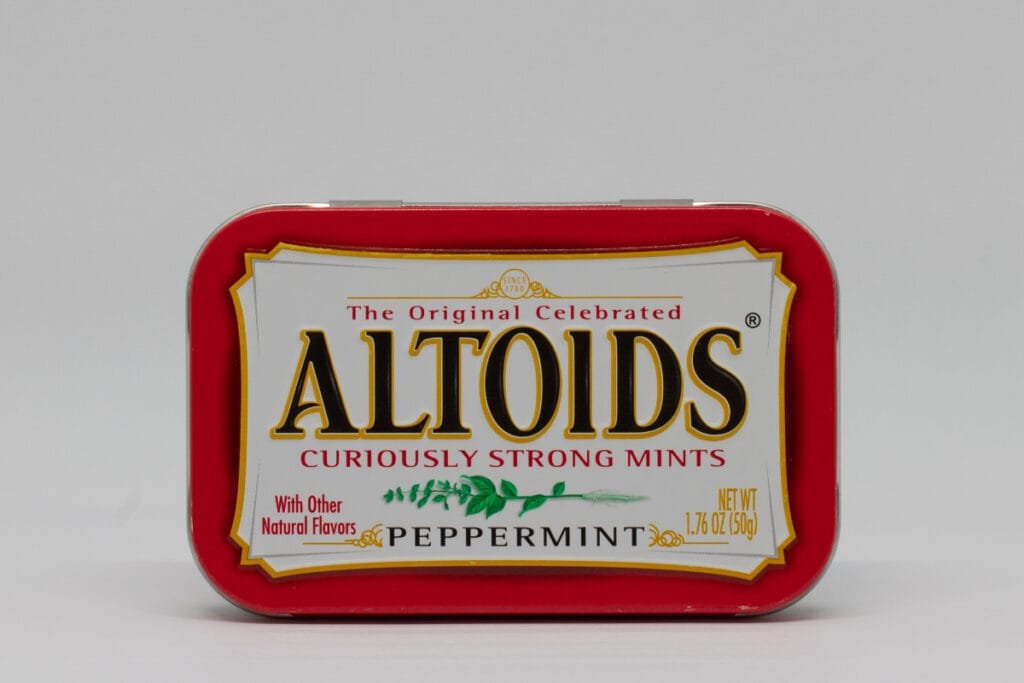
Speaking of worth, the average value of a vintage Altoids tin can range anywhere from $15 to $400 or more! Why such a huge gap? Well, there are several factors that decide whether a tin is valuable or not!
Rarity & Collectibility
The rarer an Altoids tin, the more collectible (and valuable) it will be. And to find out what makes it rare, assess the following aspects:
Discontinued Flavors
While Altoids released a wide range of flavors, some of them just didn’t make it, and now collectors pay premium prices for them. Here are some examples:
- Ginger: Super rare and has a dedicated following
- Liquorice: Hard to find and highly sought after
- Cool Honey: Unusual flavor that didn’t last long
- Crème de Menthe: Came in both regular and chocolate-dipped versions
Here’s a perfect example of how discontinuation creates value. Altoids launched sour candies in 2001, but they flopped and got discontinued in 2010. Now? Empty Altoids Sours tins sell for up to $25 on eBay and Etsy!
Limited Editions and Special Releases
Altoids tins released as promotional items for special occasions or in limited editions tend to be more collectible. So, look out for:
- Christmas-themed tins
- Valentine’s Day variants (the Love Tin)
- Corporate collaborations
- Region-specific releases
These special tins may not only feature distinctive theme-related colors, but may also come in unique shapes. For example, the Valentine’s Day special cinnamon mint tin comes in a heart shape!
Condition
Just like any collectible, the condition dramatically affects the value of old Altoids mint tins. Examples in excellent condition with no wear and tear, like scratches, dents, and paint loss, functional hinges and buttons are more collectible.
Here’s how you can grade an old tin:
- Mint Condition (Most Valuable): Looks unused, perfect paint, functioning hinges
- Near Mint: Minimal wear, maybe slight handling marks
- Excellent: Light wear but still crisp and clean
- Very Good: Moderate wear but structurally sound
- Good: Heavy wear, but complete and working
- Poor (Least Valuable): Significant damage or missing parts
The most common red flags for Altoids tins are hinge deterioration (they break easily), paint loss on high-contact areas, and rust from humid storage. These damages can cut down the value.
Packaging/Sealing
Original factory sealing can literally double or triple your Altoids tin’s worth. Here’s what to look for:
- Original shrink wrap or cellophane still intact
- Unbroken factory seals around the lid edges
- Mint contents visible through any clear packaging
- No evidence of tampering or re-sealing
Quick Tip: If you find sealed tins, keep them that way and store in cool, dry places. Temperature changes can cause the metal to expand, potentially breaking seals.
8 Examples of Rare Vintage Altoids Tins Worth Looking for!
Let’s explore some examples of rare Altoids tins – from discontinued flavors to limited editions!
1. Discontinued Altoids Raspberry Sours
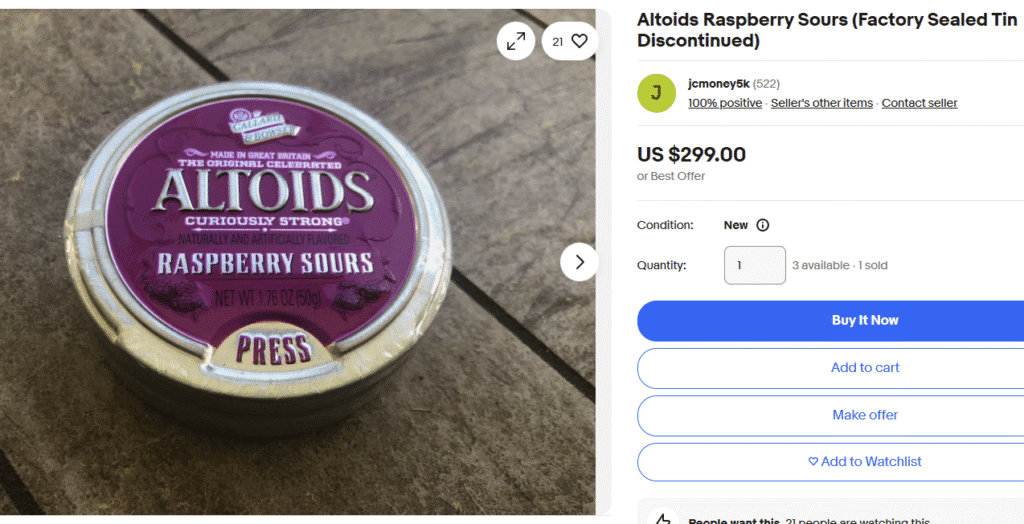
This is the iconic round Altoids Raspberry tin! What makes this tin super valuable is that Raspberry was one of the most beloved flavors in the Altoids Sours lineup! The purple-tinted label and distinctive round tin design make this tin instantly recognizable!
While rarity is the key reason for its high value, factory-sealed tins like this example typically fetch higher values. Why? Because most raspberry sour tins were consumed years ago, and finding one that’s never been opened is like striking gold!
2. Altoids Tangerine Sours Candy Tin
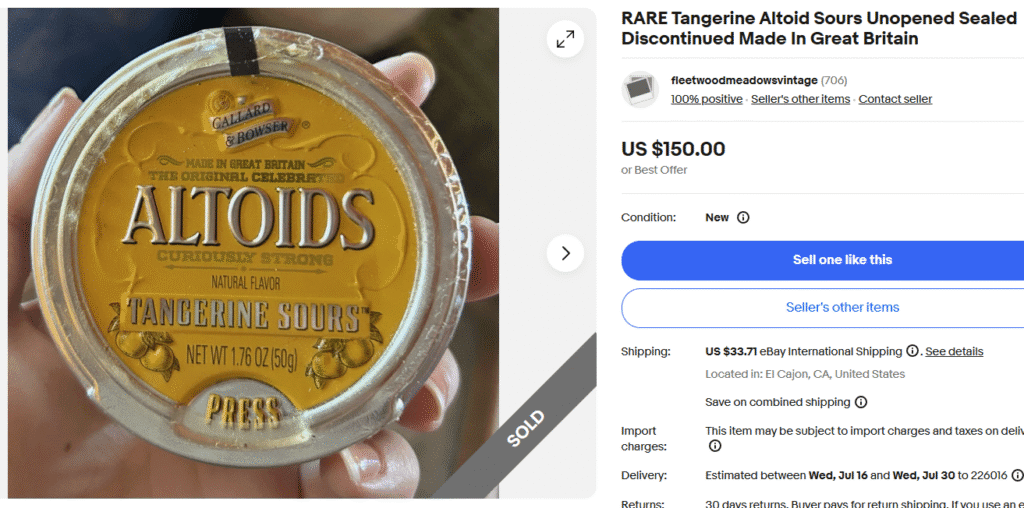
Tangerine Sours are one of the most collectible Altoids tins. These are round tins with a bright orange lid and tangerine motifs. These were part of the popular sour candy line that Altoids launched in 2001, but they were discontinued in 2010 due to low sales.
These tins become even more special when they’re factory sealed and have never been opened, like this particular example, factory sealed in Great Britain, where Callard & Bowser originally manufactured these legendary sour candies.
3. Vintage Cinnamon Altoids Tin with Sindy The Pinup Devil Girl

The iconic Sindy devil girl tins were part of Altoids’ controversial 1999-2001 advertising campaign featuring pin-up style artwork for their cinnamon mints. What makes these tins valuable is the artwork variations – some Sindy tins show her with horns, others without!
The campaign was eventually toned down, making these original “devil girl” tins instant collectibles. The pin-up model was actually Pamela Vandenberg, and the company also released some signed Sindy tins that can be more valuable than unsigned ones.
4. Limited Edition Altoids Peppermint Sealed Tin

This limited edition tin features a classic strongman illustration, showcasing Altoids’ “curiously strong” branding in a playful, vintage-style design. This piece represents Altoids’ creative marketing campaigns from the early 2000s, when they experimented with special themed packaging.
The red tin design stands out from typical Altoids packaging, making it instantly recognizable to collectors. You’ll also see the “Limited Edition TIN” label on authentic examples.
5. Discontinued Sealed Altoids Peppermints “The Tiny Tin”
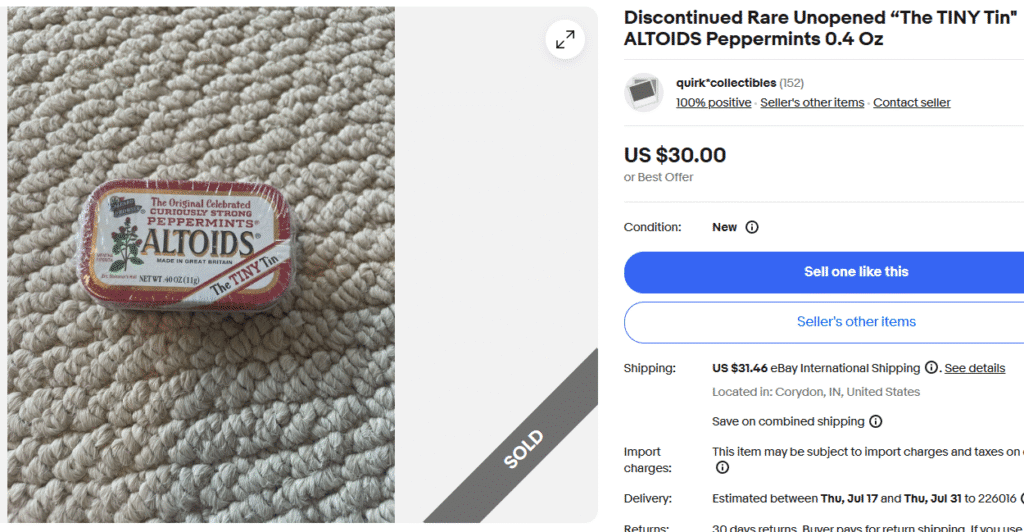
This little Tiny Tin was Altoids’ attempt at a portable, purse-friendly option before they launched the current “Smalls” line. At just 0.4 oz, this is a pocket-sized, perfect for slipping into a small purse or shirt pocket. The rectangular shape is the classic Altoids design, but in miniature form.
This special tin can be more collectible if unopened. Besides, the “Made in Great Britain” text shows this is from the original Callard & Bowser era. Despite their small size, these Tiny Altoids tins can sell for $15-$50, thanks to their rarity!
6. Discontinued Altoids Ginger Mint Tin
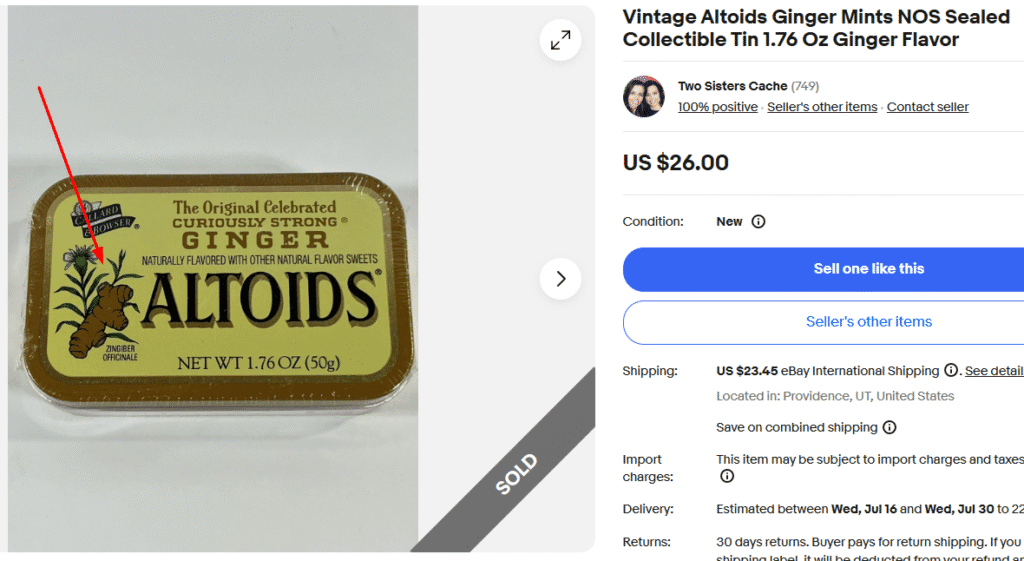
This tin belongs to one of Altoids’ most beloved discontinued flavors – ginger (a warm, spicy kick instead of the usual cool mint sensation). The tin features gorgeous botanical artwork with ginger root illustrations on a bright yellow background.
Apart from its rarity, the original factory sealing also adds to the value of this rare Altoids tin. Unsealed examples or empty tins will likely fetch below $15.
7. Rare Altoids Cinnamon “The Love Tin”

This tin is an example of promotional and special limited-edition Altoids tins. This was released for Valentine’s Day marketing. It’s an adorable heart-shaped tin, holding 2.29 oz compared to the regular 1.76 oz rectangular tins.
The distinctive shape made it perfect for romantic Valentine’s Day gifts! Since this was an empty tin, it sold for $17; factory-sealed tins with original mints inside can hike the value to up to $30-$50!
8. Altoids Wintergreen Mints Silver Tin
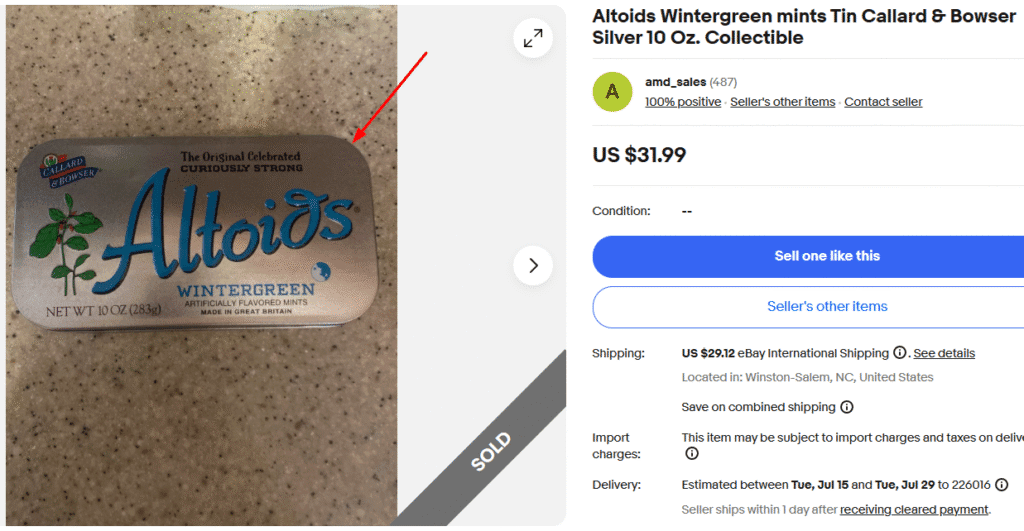
This vintage Altoids tin will take you back to the brand’s British roots. The 10 oz size and silver background are what make this piece special – it’s a massive tin compared to the standard 1.76 oz we’re used to today.
Besides, you’ll see the “Callard & Bowser” marking, which means it was made before Mars took over production. You can easily spot this tin by the distinctive mint leaf artwork for the wintergreen flavor!
Note: This article is intended for informational, educational, and entertainment purposes only. Some images are illustrative and may not represent actual brands, products, or related entities. All trademarks, product names, brand logos, packaging, and other intellectual property referenced remain the exclusive property of their respective owners. Any brand mentions or references are provided solely for descriptive and educational context and do not imply any formal or commercial association.



